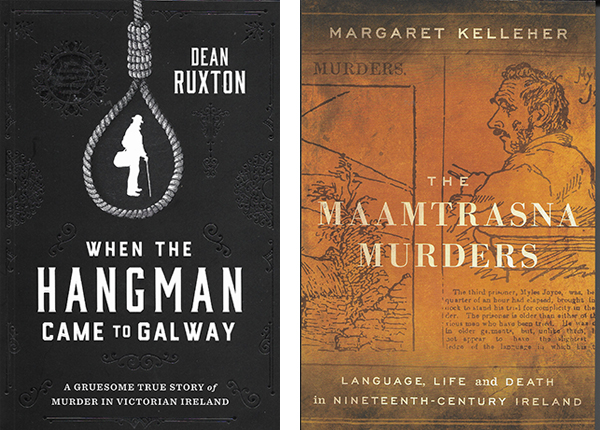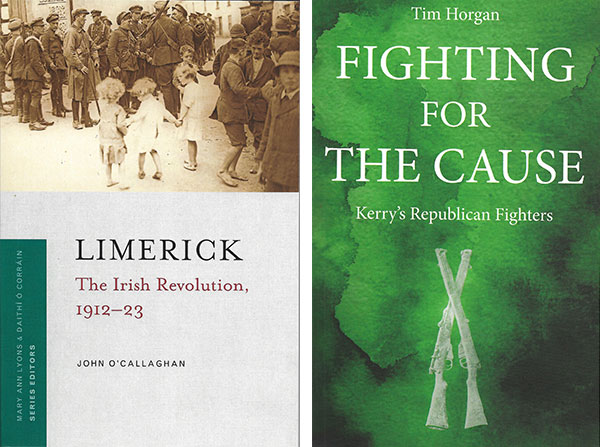BOOKWORM
Published in Book Reviews, Issue 1 (January/February 2019), Reviews, Volume 27By Joe Culley
If you like your history spiced up with a bit of true crime, then Dean Ruxton’s When the hangman came to Galway will be just the ticket. In 1894–5 both the town of Galway and the nation were gripped by two murders, one in a hotel in Eyre Square, the other in a field in Clonboo on the eastern shore of Lough Corrib. Broken relationships feature in both. While Ruxton goes into great detail about the murders and the police investigations, much of the book’s focus is on James Berry, the hangman from Bradford, England, who was employed to dispatch the two convicted parties.
Ruxton is blessed in having access to a great deal of original source material, not least because Berry kept a detailed diary and eventually published an autobiography, in part to salvage his reputation—not every hanging proceeded according to plan. The police and court records of the outrages and trials are also substantial, as are the newspaper accounts. Ruxton alternates the storytelling between straightforward reporting—just the facts, ma’am—and fictionalised, dramatic reconstructions of crucial scenes. He makes a solid fist of his role as a novelist.
As it happens, James Berry’s predecessor and mentor as the crown’s principal hangman was one William Marwood, who three years earlier in Galway had botched the job on Myles Joyce, an innocent man executed for his alleged role in the infamous Maamtrasna murders. When the trapdoor dropped, Joyce’s arm got caught in the rope, and it took several minutes for him to die from strangulation. It’s thought that Marwood actually stood on the poor man’s head to hasten the process.

This, of course, is a small part of the story retold in Margaret Kelleher’s impressive The Maamtrasna murders: language, life and death in nineteenth-century Ireland, which was widely praised on its publication in November 2018. As the title suggests, Kelleher addresses the case with a particular emphasis on the use of language in an isolated region. Joyce famously spoke only Irish but was denied a translator during his trial, and Kelleher broadens this question of a denial of human rights to a global perspective.
The border has been in the news recently and you might think you know how it came to exist in the first place, but even the experts should have a look at Ivan Gibbons’s superb Drawing the line: the Irish border in British politics. This lively, concise little pamphlet, about A6 size, examines, from the perspective of Westminster, how the Irish Question, in the shape of Home Rule, tormented various cabinets for the 40 years leading up to partition. Gibbons parses the machinations that led to the creation of a border and examines the reasons for decades of British indifference to and ignorance of the subject. As Gibbons observes, ‘… it is an irony that the only part of Ireland not wanting Home Rule was the only part to get it’. And nothing has changed: the only grouping quietly hoping for the return of a hard border is the DUP. An excellent read.
At the start of the Emergency, the director of the National Library, Dr Richard Hayes, a gifted mathematician and polyglot, was quietly engaged by Army intelligence to assist in handling the series of German spies (some almost comically inept) who found their way to the Free State. In the process, Hayes, almost single-handedly, cracked several of the codes the spies were using, codes that had left Bletchley Park baffled. It’s an extraordinary tale. Unfortunately, the telling of it in Marc McMenamin’s Code-breaker is less extraordinary. McMenamin is not helped by his editors, either on the large scale (the story is enmeshed in a muddled chronology) or on the small (e.g. Austin Stack did not die on hunger strike in 1929 and Cathal Brugha did not die from injuries sustained at the Four Courts). There is a great deal of fascinating detail here, but at times you’ll feel like a code-breaker yourself in trying to determine exactly what it is.
Based on a popular BBC Ulster radio series, Jonathan Bardon’s entertaining A narrow sea charts the intense relationship between the north-east corner of this island and their (often literal) cousins across the strait in Scotland. There are 120 stand-alone chapters/episodes, ranging from ancient Dál Riata to modern football rivalries.

Des Kiely—described as a blow-in—has produced Famous Wexford people in history. There are 38 entries (who knew?), among them the remarkable Speranza, United Irishmen, artists, politicians, Hollywood actors and many more. Kiely has an easy style and the stories are well told.
As the decade of commemoration now moves on to the War of Independence and eventually to the Civil War, we can look forward to a raft of intimate local histories. No doubt these will include previously overlooked—or, indeed, buried—details and truths. Among the most recent are Conor McNamara’s War and revolution in the west of Ireland: Galway 1913–1922, John O’Callaghan’s The Irish revolution, 1912–23: Limerick (part of the Four Courts series) and Tim Horgan’s Fighting for the cause: Kerry’s republican fighters.

Dean Ruxton, When the hangman came to Galway: a gruesome true story of murder in Victorian Ireland (Gill Books, €16.99 pb, 224pp, ISBN 9780717180851).
Margaret Kelleher, The Maamtrasna murders: language, life and death in nineteenth-century Ireland (UCD Press, €20 pb, 368pp, ISBN 9781910820421).
Ivan Gibbons, Drawing the line: the Irish border in British politics (Haus Publishing, £7.99 pb, 90pp, ISBN 9781912208296).
Marc McMenamin, Code-breaker: the untold story of Richard Hayes, the Dublin librarian who helped turn the tide of World War II (Gill Books, €16.99 pb, 256pp, ISBN 9780717181612).
Jonathan Bardon, A narrow sea: the Irish–Scottish connection in 120 episodes (Gill Books, €24.99 hb, 288pp, ISBN 9780717180592).
Des Kiely, Famous Wexford people in history (Parsifal Press, €16 pb, 144pp, ISBN 9780993396052).
Conor McNamara, War and revolution in the west of Ireland: Galway 1913–1922 (Irish Academic Press, €16.99 pb, 220pp, ISBN 9781785371608).
John O’Callaghan, The Irish revolution, 1912–23: Limerick (Four Courts Press, €17.95 pb, 192pp, ISBN 9781846827426).
Tim Horgan, Fighting for the cause: Kerry’s republican fighters (Mercier Press, €17.99 pb, 336pp, ISBN 9781781175613).
















